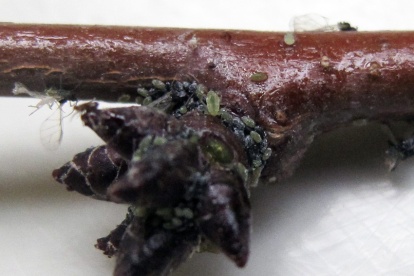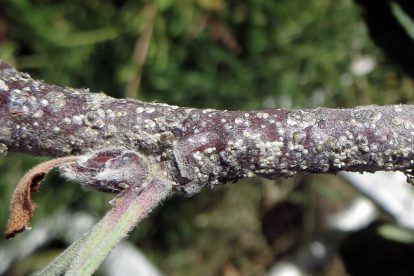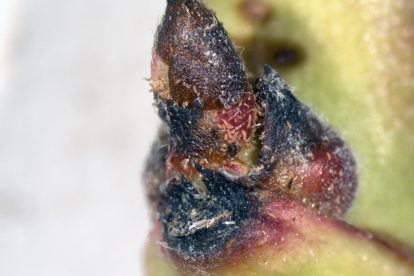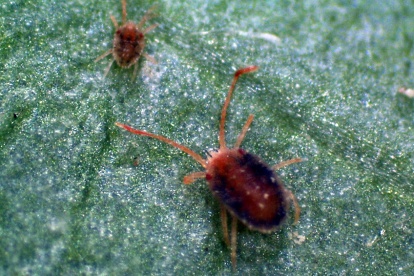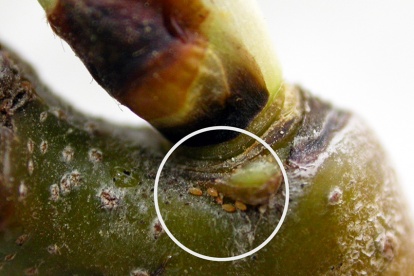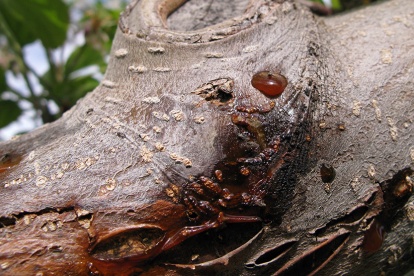In this Issue
- Delayed-dormant Oil Spray – applied before bloom
- Copper Spray Options – for fire blight and peach leaf curl
- Examples of Insects and Diseases Affected by Oil or Copper Spray
- Pear Fruit Sawfly – controlled with insecticide before bloom
Dormant Oil Spray
The use of horticultural oil before bloom can target many insect pests (see images below, and see more explanation about oil below under “Backyard”). You are likely familiar with the term, “dormant oil,” but the application is applied after trees break dormancy (but before bloom). In other words, the oil should be applied around bud swell or later. This timing matches up with the increasing activity of the overwintering insect stages, such as aphid eggs, scale nymphs, and peach twig borer larvae. If applied too early, the oil will not work as well on these insects.
In the warmest areas of Utah, trees are blooming or past bloom, so the oil may already have been applied. But in northern Utah, it is time to apply the spray if not done already.
Should I Spray?
If your fruit trees are not affected by the pests in the image gallery shown below, you can skip the oil application.
When Should I Spray?
There are two factors to consider for determining when to spray: the bud stage of your fruit trees (pictures of fruit bud stages), and weather conditions.
Bud Stages
The window for application extends from bud swell to when leaves start emerging, usually a period of several weeks, depending on the tree.
The last point at which you can safely apply oil (at the recommended rate below) for each crop is:
- apple: half-inch green (ideally, application is made at green tip stage)
- cherry: white bud
- pear: green cluster
- peach/nectarine: just before first bloom (when the pink shows through the flower bud)
- plum: green cluster
Weather Conditions
- Only apply oil if temperatures remain above freezing (ideally above 40°F) for 24 hours after application.
- Ideally, oil should be applied on a clear, non-windy day in the 50° to 70°F temperature range.
- Do not apply if rain is predicted within 24 hours. This will help give the oil time to work.
How to Spray
Commercial growers
- Oil should be applied at a rate of 2-3%, which is 2-3 gallons per 100 gallons of water.
- (Optional) Mix oil with an insecticide such as Warrior or Asana to help improve knockdown of overwintering pests.
- When spraying apple or pear trees, it is OK to mix in copper for fire blight.
- Thoroughly cover all cracks and crevices of the tree bark and buds.
Backyard growers
- Oil should be applied at a rate of 2%, which is 5 Tbs in 1 gallon of water.
- If you are not growing organically, and aphids or scale have been a serious problem and oil alone has not worked in past years, consider mixing the oil with the appropriate rate of an insecticide, such as Spectracide Triazicide, GardenTech Sevin, or Malathion.
- When spraying apple or pear trees, it is OK to also mix in the proper rate of copper to help prevent fire blight bacteria from multiplying.
- Make sure you thoroughly cover all cracks and crevices of the bark and buds.
More details about oil
- Oil is sold as a concentrate, so it must be mixed at the proper rate with water before application.
- There are plant-based oils and petroleum-based oils. For the dormant oil application, the petroleum-based oils work the best, although canola-based oil is another option.
- Petroleum-based oils – There are many brands, and they all work the same. Examples include All Seasons Horticultural Oil, Monterey Horticultural Oil, Gordon’s Dormant Oil Spray, Ortho Volk Spray Oil, Hi Yield Dormant Oil, etc.
- Plant-based oils – One example is Natria Multi-Insect Control, and there are many others.
Dormant Copper Products
In Utah, copper can be used on apple and pear as a management tool for fire blight, or on peach/nectarine to help prevent peach leaf curl. See images below.
| Ingredient | Commercial Options | Residential Options | Comments |
|---|---|---|---|
| basic copper sulfate | Cuprofix Ultra Disperss; Basic Copper Sulfate; C-O-C-S | Effective, but should only be used before leaf emergence or in the fall | |
| copper oxide | Nordox | ||
| copper hydroxide | Kocide; Champ; Badge SC; NuCop; Previsto | Previsto has a low copper concentration | |
| copper diammonia diacetate complex | Monterey Liqui-Cop | ||
| copper octanoate (soap) | Cueva | Gardens Alive Soap Shield; Bonide Liquid Copper Fungicide; Natural Guard Copper Spray; Espoma Copper Soap | Has lower metallic copper concentration; safer on plants; effective |
| copper sulfate pentahydrate | MasterCop; Phyton | Not as effective as a dormant application. | |
Some Insects and Diseases Affected by an Oil or Copper Spray
Click on an image for caption information.
Pear Fruit Sawfly
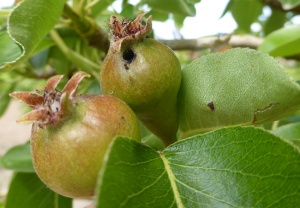
Pear fruit sawfly (Hoplocampa brevis) affects young pear fruitlets, causing them to drop. The adult is a small, fly-like wasp that is reddish-yellow in color. Females lay eggs inside flowers, and the hatched larva feeds exclusively within the developing pear for approximately six weeks from early to mid-spring. After this time, the insect goes into a dormant stage until the following spring.
Symptoms of pear fruits with affected by larval feeding within the fruit include:
-
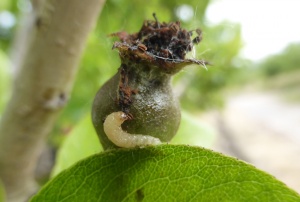
Pear fruit sawfly larva exiting a fruit. deformed and swollen shape
- blemished skin
- round hole located near the calyx, accompanied by black decay and wet frass
- premature fruit drop
To distinguish pear fruit sawfly from codling moth, keep these factors in mind:
- symptoms of pear fruit sawfly will appear several weeks before codling moth
- sawfly frass is wetter and darker
- sawfly larvae are smaller, darker in color, and have 7 pairs of prolegs (as opposed to codling moth’s 5)
Several Utah locations have been affected by this pest, but the fruit injury will fluctuate from year to year. The insect population size and amount of damage depends upon the previous year’s damage level, whether adult flight is synchronized with pear bloom, the level of fruit set, and overwintering conditions.
If the crop load is high, anecdotal evidence suggests that damage from pear sawfly will be “absorbed” by crop thinning, and therefore, intervention may not be necessary. If the crop load is light, the injury could cause a greater negative impact.
Treatment
- Utah pear growers have found success with a single insecticide treatment applied just before bloom.
- They reported that the use of horticultural oil (2% rate) mixed with a broad-spectrum insecticide (such as carbaryl, a pyrethroid, or diazinon) labeled for pear, have reduced losses.
- Do not spray too early, or the treatment will miss the arrival of the adults.

